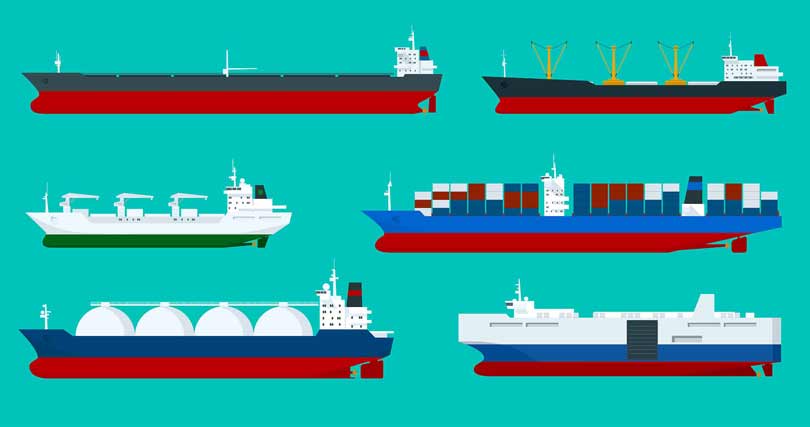The keel of a ship is a central longitudinal structural element that is located at the bottom of the ship and extends from the bow to the stern. The keel is laid as the first part of the structure and then the looms, frames and edges are added to it to construct the basic part of the hull. Frames represent the transverse or rarely the longitudinal part of the ship’s frame to which steel (or wooden) slab panels are attached. Modern ships have almost exclusively only transverse ribs or transverse ribs with a few longitudinal reinforcement ribs, while longitudinal ribs were often used during and after World War II (the most famous were the Liberty ships).

The ribs are numbered from the most outward stern frame (rib No 1) continuing all the way to the bow. The numbering is particularly important in the carriage of bulk loads, where the exact longitudinal position of the load is given by indicating between which two frames it is located. 9 Bulkheads are transverse or longitudinal structural elements in the hull of a ship that divide it into separate spaces. The most important are the watertight bulkheads, which are designed to limit the ingress of water in the event of a flooding incident. The number of watertight bulkheads is prescribed by the SOLAS Convention. Normally, cargo ships only have transverse bulkheads, while some other types of ships (e.g. tankers) also have longitudinal bulkheads. If passageways (e.g. corridors in passenger ships) pass through an airtight bulkhead, they must be constructed so that they can be closed in a way that is completely watertight. Watertight bulkheads are also usually used to separate the ship’s storage facilities and are also usually marked on the vast majority of ships.
This way, port workers can see where the boundaries between warehouses are and can put port machinery in place. Since the bulkheads are also reinforced, these markings are also useful for tugboats in order to use those reinforced spots to push the ship. FP 1 5 6 8 ER Holds are cargo spaces. Their structure, position, size, number and shape depend on the type of a ship. Passenger ships have cabin spaces and other spaces for passengers instead of holds. Hatches are deck openings through which the cargo is loaded into holds. Their structure, position, size, number and shape also depend on the type of a ship. The hatches must be covered to prevent water from entering the holds.
Covers are used to cover the hatchets, which can be classic, pontoon or folding (Mc Gregor). The size of the hatch and its protection is a decisive factor in determining the allowed freeboard. Cargo handling equipment depends on the expected cargo that the ship will carry in its lifetime. Since cargoes are very different in their characteristics (liquid, dry, bulk, bulky, heavy, volumetric, perishable, etc.), the cargo equipment on ships also varies. On tankers, for example, cargo equipment consists of pumps, pipelines, valves, etc., meanwhile cargo equipment on a ro-ro ship consists of ramps and lifts. The cargo equipment for each type of ship will be described in more detail below. It is very important that we know the characteristics of the cargo handling equipment. In case of miscellaneous lifts and ramps, the most important thing is to know the safety working load and safe operating angle.
The safe working load on lifts is marked as SWL, followed by the working load and in some cases, the minimum working angle. SWL 10t 15 ° 10 For elevators working in pairs (ala americana in the nautical jargon) the carrying capacity is reduced by half. For example, if the elevator has a load capacity of 10 t, it can only lift 5 t when working in pairs. Some specialized ships, especially of larger dimensions, such as container ships, bulk carriers, etc., are usually without their own cargo handling equipment (gearless) and depend on port throughput capacity. The cargo equipment on every ship must be regularly maintained and inspected. Baha maritime Sarl, can do this task for you in Guinean ports in Africa.
It should also be periodically reviewed by an expert and especially in an event of any kind of defect. Double bottom is the space at the bottom of the ship intended for tanks. Double bottom tanks usually serve as ballast tanks or tanks for fuel storage, and rarely for fresh water. At the same time they serve as additional protection for the ship and cargo in the event of a shipwreck. Ship tanks are spaces on a ship intended for the storage of liquids. We distinguish cargo tanks, ballast tanks, fuel tanks, fresh water tanks and waste fluid tanks. Cargo tanks are used for the transport of liquid cargo. Only tankers and a few general cargo ships have cargo tanks. Their position, structure and the material from which they are made depend on the characteristics and the amount of cargo the ship is carrying. Thus the whole structure of the ship is adapted to it.
